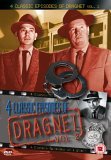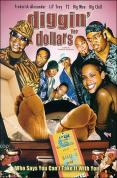 Under the Dome - Season 3 | DVD | (07/04/2016)
from £N/A
| Saving you £N/A (N/A%)
| RRP
Under the Dome - Season 3 | DVD | (07/04/2016)
from £N/A
| Saving you £N/A (N/A%)
| RRP ![And Now For Something Completely Different [1971]](/pictures/1015216.jpg) And Now For Something Completely Different | DVD | (28/07/2003)
from £6.16
| Saving you £6.83 (110.88%)
| RRP
And Now For Something Completely Different | DVD | (28/07/2003)
from £6.16
| Saving you £6.83 (110.88%)
| RRP And Now for Something Completely Different, Monty Python's first feature, is a reworking of their best skits from the first two seasons of the TV series. Originally made for the US market (where the show had yet to be aired), it was shot on film outside the usual studio sets ("Nudge Nudge", for example, is set in a tavern filled with passers-by). The writing and performances are fine and the film is packed with some of their best bits: "How to Avoid Being Seen", " Hell's Grannies", "Blackmail", "The Lumberjack Song" and "The Upper Class Twit of the Year", among others. Many of the sketches have been shortened, however, and the loss of the overly bright video sheen (the film has a muddy, dull look to it) and the invigorating presence of a live audience leaves the film sluggish at times. They're still feeling out the possibilities of the feature length, which they conquered with their next movie, Monty Python and the Holy Grail (1974). --Sean Axmaker
![Cats & Dogs [2001]](/pictures/1009777.jpg) Cats & Dogs | DVD | (03/12/2001)
from £4.96
| Saving you £9.03 (182.06%)
| RRP
Cats & Dogs | DVD | (03/12/2001)
from £4.96
| Saving you £9.03 (182.06%)
| RRP For thousands of years a war has raged right under the noses of human beings and we've never even suspected it. Now the battle between cats and dogs is hotting up, as the cats set out to make everyone allergic to dogs!
![White Palace [1990]](/pictures/1018647.jpg) White Palace | DVD | (17/04/2019)
from £N/A
| Saving you £N/A (N/A%)
| RRP
White Palace | DVD | (17/04/2019)
from £N/A
| Saving you £N/A (N/A%)
| RRP Glenn Savan's depressing and self-loathing novel about a 27-year-old upper-class Jewish widower mired in self-pity after his beloved wife dies, and who finds love and sexual rebirth with a trailer-trash older woman, was brought to the big screen by the competent director Luis Mandoki (When a Man Loves a Woman, Message in a Bottle). But the savage irony in Savan's book has been face-lifted by screenwriters Ted Tally (The Silence of the Lambs) and Alvin Sargent (Ordinary People) into something else entirely: what passes for low-rent "slumming" in Hollywood means hiring sexy Susan Sarandon to play Nora Baker, the poor, uneducated 43-year-old waitress in a White Palace burger joint who strikes up an unlikely relationship with sad Max Baron (James Spader). Widower Max attends a bachelor party for best pal Neil (Jason Alexander) and discovers that the local White Palace has stiffed the boys a whopping six burgers. Max barges into the joint, bent on getting his money back, and meets a testy Nora, who is bemused at the young man's insolence. While driving home, Max stops abruptly at a bar for a drink. Inside, Nora is nursing a vodka and takes a shine to the tuxedo-clad, handsome, and morose younger man. He gives her a lift, she seduces him, and the rest of the movie examines how two such opposites in manners and morals can find happiness. The only common bond they have is great sex and a private tragedy. White Palace nudges at the dark journey and the smashing of illusion that was at the heart of the novel, but there is still a fairy-tale element to the film that negates the earthy essence that distinguished the book. In Mandoki's vision, White Palace is about overcoming class, family, and outside opinion to find true love. In Savan's book, Max wastes into decline while Nora ultimately thrives in the quest for truth, redemption, and self-forgiveness. She becomes his salvation only after he stops hating himself. But mainstream Hollywood shuns making "protagonists" so mad, bad, or sad, and as such, too much glitter is tossed on Spader, while Sarandon, as usual, is the only one who seems to embody and understand her character's angst. She deserved her Oscar for Nora, not the nun in Dead Man Walking. --Paula Nechak
 Three Up, Two Down | DVD | (17/05/2004)
from £N/A
| Saving you £N/A (N/A%)
| RRP
Three Up, Two Down | DVD | (17/05/2004)
from £N/A
| Saving you £N/A (N/A%)
| RRP A pair of widowed grandparents are forced to cohabit in their children's basement. Daphne (Angela Thorne) is a snobby Cheltenham-bred lady while Sam (Michael Elphick) is the cockney wide boy who has designs on Daphne. First broadcast in 1985 this release includes all the episodes from Series One and Two of Three Up Two Down. Episode titles: Your Place Or Mine? Widower's Mite Ill Wind From Cheltenham Epping's Not Far Just Desserts Two Down One To Go Major Inconvenience Sweet
![Going Off Big Time [2000]](/pictures/1023035.jpg) Going Off Big Time | DVD | (16/04/2001)
from £6.73
| Saving you £13.26 (197.03%)
| RRP
Going Off Big Time | DVD | (16/04/2001)
from £6.73
| Saving you £13.26 (197.03%)
| RRP New Brit gangster pic about the irresistible rise of a Merseyside 'firm.'
![Cats & Dogs [DVD]](/pictures/1102879.jpg) Cats & Dogs | DVD | (04/10/2010)
from £4.99
| Saving you £8.00 (160.32%)
| RRP
Cats & Dogs | DVD | (04/10/2010)
from £4.99
| Saving you £8.00 (160.32%)
| RRP Things Are Gonna Get Hairy! They're cunning. They're stealthy. They're waging a top-secret ultra-high-tech struggle for global domination right under our noses. They're Cats & Dogs! Witness this epic tail of what happens when an eccentric professor (Jeff Goldblum) makes a discovery that could tip the age-old balance of pet power. Now an inexperienced young beagle pup named Lou (voiced by Tobey Maguire) is about to begin the ultimate mission im-paws-ible: to save humanity from a total cat-tastrophe!
![Day Of The Dead [1986]](/pictures/1023279.jpg) Day Of The Dead | DVD | (06/09/1999)
from £17.97
| Saving you £-1.99 (N/A%)
| RRP
Day Of The Dead | DVD | (06/09/1999)
from £17.97
| Saving you £-1.99 (N/A%)
| RRP Day of the Dead, chapter three of George Romero's mighty zombie trilogy, has big footsteps to follow. Night of the Living Dead was a classic that revitalised a certain corner of the cinema, and Dawn of the Dead was nothing short of epic. Day of the Dead, however, has always been regarded as a comedown compared to those twin peaks--and perhaps it is. But on its own terms, this is an awfully effective horror movie, made with Romero's customary social satire and cinematic vigour--when a "retrained" zombie responds to the "Ode to Joy", the film is in genuinely haunting territory. The story is set inside a sunken military complex, where Army and medical staff, supposedly working on a solution to the zombie problem, are going crazy (strongly foreshadowing the final act of 28 Days Later). Tom Savini's make-up effects could make even hardcore gore fans tear off their own heads in amazement. --Robert Horton
![Birthday Girl [2002]](/pictures/1014746.jpg) Birthday Girl | DVD | (28/04/2003)
from £N/A
| Saving you £N/A (N/A%)
| RRP
Birthday Girl | DVD | (28/04/2003)
from £N/A
| Saving you £N/A (N/A%)
| RRP Nadia is the mail-order bride of sweet but dull bank clerk John, and although she's as beautiful as he hoped she's hardly the ideal non-smoking, English speaking wife he hoped for...
![Cop And A Half: New Recruit [DVD]](/pictures/1144454.jpg) Cop And A Half: New Recruit | DVD | (14/08/2017)
from £4.95
| Saving you £1.04 (21.01%)
| RRP
Cop And A Half: New Recruit | DVD | (14/08/2017)
from £4.95
| Saving you £1.04 (21.01%)
| RRP Grizzled veteran detective Mark Simmons (Lou Diamond Phillips) can't seem to catch the Badge Bandit the city's serial prankster who's causing mischief and embarrassing the police. Karina Murphy (Lulu Wilson) is a spunky 12-year-old who dreams of being a cop. She stumbles on Simmons' stakeout where she proves she's got serious detective skills and tech-savvy smarts. While Simmons wants to ignore Karina, the police captain does the unthinkable and teams them up. While on their mission to stop the Badge Bandit, the unlikely duo goes on a hilarious, action-filled adventure! Bonus features: The Making of Cop and a Half: New Recruit Lou and Lulu: Partners in Crime Solving
![The Saint - Vol. 1 - Episodes 1 And 2 - The Talented Husband / The Latin Touch [1962]](/pictures/1004406.jpg) The Saint - Vol. 1 - Episodes 1 And 2 - The Talented Husband / The Latin Touch | DVD | (10/07/2000)
from £N/A
| Saving you £N/A (N/A%)
| RRP
The Saint - Vol. 1 - Episodes 1 And 2 - The Talented Husband / The Latin Touch | DVD | (10/07/2000)
from £N/A
| Saving you £N/A (N/A%)
| RRP Stepping into the role of Leslie Charteris' "modern-day Robin Hood" Simon Templar (formerly played in films by smoothies like George Sanders), Roger Moore swiftly struck the right poses, adding a raised eyebrow to the character's established trademarks--a stick figure with halo, a whistled theme (co-composed by Charteris himself) and a quixotic commitment to adventure rather than decency. More clean-cut than the vigilante of the novels, Moore's Templar is a reformed thief (with an accent on reformed) whose adventures invariably involve a beautiful girl in trouble, an exotic locale established by stock shots and pantomime-level barroom sets with revolving fans on the ceiling, and "foreign" villains, played by familiar British character actors in false moustaches. The Saint ran from 1962 to 1969. Connoisseurs reckon the earlier, black and white shows are superior to the later colour seasons. From 1979 to 1980, there was a follow-up, The Return of the Saint, in which sufficiently ironic Ian Ogilvy donned Templar's polo neck, but the format seemed outmoded in comparison with The Sweeney and The Professionals. Volume One contains: "The Talented Husband" in which a playwright is found dead in suspicious circumstances, with guest star Shirley (Goldfinger) Eaton; and "The Latin Touch" which concerns a kidnapping in Rome, with Suzan Farmer and Warren (Alf Garnett) Mitchell. --Kim Newman
![Cry Of The Innocent [1980]](/pictures/1053410.jpg) Cry Of The Innocent | DVD | (21/06/2004)
from £8.98
| Saving you £-4.99 (N/A%)
| RRP
Cry Of The Innocent | DVD | (21/06/2004)
from £8.98
| Saving you £-4.99 (N/A%)
| RRP  Dragnet - 4 Classic Episodes - Vol. 2 - Drug Pushing Teenager / Assault And Robbery / Bit Batty / Big Number | DVD | (04/04/2005)
from £4.98
| Saving you £0.01 (0.20%)
| RRP
Dragnet - 4 Classic Episodes - Vol. 2 - Drug Pushing Teenager / Assault And Robbery / Bit Batty / Big Number | DVD | (04/04/2005)
from £4.98
| Saving you £0.01 (0.20%)
| RRP Features the four episodes 'Drug Pushing Teenager' 'Assault And Robbery' 'Big Betty' and 'Big Number'.
![Dilemma [1997]](/pictures/1019685.jpg) Dilemma | DVD | (09/09/2002)
from £N/A
| Saving you £N/A (N/A%)
| RRP
Dilemma | DVD | (09/09/2002)
from £N/A
| Saving you £N/A (N/A%)
| RRP A little girl lies in hospital dying of cancer. Death row inmate Rudy Salazar has the bone marrow that could save her life. When Salazar dissapears en route to the hospital and begins another reign of terror Quin sets out to hunt him down but is under strict orders to keep him alive.
 The Hollywood Comedy Box Set | DVD | (30/01/2002)
from £N/A
| Saving you £N/A (N/A%)
| RRP
The Hollywood Comedy Box Set | DVD | (30/01/2002)
from £N/A
| Saving you £N/A (N/A%)
| RRP Five great comedy films in one amazing value box set! I Don't Buy Kisses Anymore The heartwarming story of an unlikely romance between a quiet shy and somewhat overweight shoe salesman and the outgoing beautiful psychology student whose initial interest in him is purely academic. Or is it? When The Party's Over It's a non-stop party for a group of beautiful teens living it up in a posh area of Los Angeles. And one very sexy lady M.J. has found a congenial way to capitalize on her friendships and advance her position. But when the music stops and the mad whirl starts to slow down M.J. must suddenly face up to a void in her life. Picking Up The Pieces Tex (Woody Allen) a kosher butcher from New York under the witness protection program in Arizona has a problem. He has just killed his wife Candy (Sharon Stone) in a jealous rage after discovering she's having an affair with the local sheriff (Keifer Sutherland). He's cut her body into pieces and has taken them to the Mexican border but he's lost one of her hands! A blind old village woman stumbles upon the hand hits her head and miraculously regains her eyesight. Soon thousands are flocking to the local church to see the hand of the 'Madonna' and miracles are granted to all who ask. But the village priest (David Schwimmer) who is in love with the town hooker (Maria Grazia Cucinotta) senses that the hand's origin is not quite 'virginal'. Tex the Sherrif and the Priest all want something done with the hand and the unpredictable outcome proves to be both magical and hilarious! Combat Academy A wise-cracking hipster and a nerd are sent to a military academy to be straightened out. But the two manage to turn the academy inside out with their comic capers and war games! Better Living Nora (Olympia Dukakis) and her three grown daughters living in the suburbs of New York City are stunned when Tom (Roy Scheider) Nora's husband and the father of the girls comes back after 15 years and reunites their family. But he has changed. He insists that the family build a shelter underneath their house in which to live. 'Better Living' is an intrigueing psychological family portrait that is at once funny and frightening.
![Abbott And Costello - Laugh-A-Thon [1949]](/pictures/1012517.jpg) Abbott And Costello - Laugh-A-Thon | DVD | (21/04/2003)
from £N/A
| Saving you £N/A (N/A%)
| RRP
Abbott And Costello - Laugh-A-Thon | DVD | (21/04/2003)
from £N/A
| Saving you £N/A (N/A%)
| RRP Abbott & Costello Classic Comedies three-disc collector's set consists of oddments from the latter days of their career that have fallen into public domain; which means you don't get their best routines or classiest productions, and indeed find the double act doing fairly tired schtick as Costello is chubbily chicken-hearted and Abbott grumpily money-grubbing. Africa Screams is a 1949 safari parody, with Costello running away yelping from sundry alligators, gorillas (including a Kong-sized giant), cannibals ("Chief have sweet tooth for little fat man") and lions amid backlot jungles as Abbott competes with stock villains for a fortune in diamonds. Jack and the Beanstalk, from 1952, finds the duo attempting to sell themselves as children's entertainers in a Wizard of Oz-influenced fairytale book-ended by sepia modern-day segments. The magical story unfolds in wonderfully gruesome cheap colour with some of the worst musical numbers ever committed to film ("he's perpendicular-la-la") as Jack the Clod (Costello) and Mr Dinkelpuss the Butcher (Abbott) climb the beanstalk and plod around the Giant's lair until the story runs out. Possibly the most interesting item is the third disc, which offers an episode of the Colgate Comedy Hour (aka The Abbott and Costello Show) from the 1950s. It shows the pair doing live routines closer to their original vaudeville act than their film roles (including an amazingly cruel bit in which Abbott slaps Costello every time he says the word "tin"). A loose plot about Latin American intrigue, with Lou hired to stand in for an assassination target "El Presidente", makes room for speciality guest stars ranging from child xylophonist Baby Mistin to four starlets (including Jane Russell and Rhonda Fleming) harmonising on a "Happy Easter" medley. Best of all, and now funnier than the comedy, are original hard-sell ads for household products like "Ajax, the foaming action cleanser" and "Halo, the shampoo that glorifies your hair". --Kim Newman
 Diggin' For Dollars | DVD | (16/07/2007)
from £4.84
| Saving you £11.41 (318.72%)
| RRP
Diggin' For Dollars | DVD | (16/07/2007)
from £4.84
| Saving you £11.41 (318.72%)
| RRP Who Says You Can't Take It With You? Kevin and Paul are 2 old friends looking to have a good time. They join their friend Big Bear a compulsive gambler for a night of laughter and ladies. Before the night is through Big Bear will lose the biggest gamble of all his life. However he does take a valuable secret to the grave with him.
![And Now For Something Completely Different (Collector's Edition) (DVD) [1971]](/pictures/1072445.jpg) And Now For Something Completely Different (Collector's Edition) (DVD) | DVD | (03/05/2004)
from £N/A
| Saving you £N/A (N/A%)
| RRP
And Now For Something Completely Different (Collector's Edition) (DVD) | DVD | (03/05/2004)
from £N/A
| Saving you £N/A (N/A%)
| RRP And Now for Something Completely Different, Monty Python's first feature, is a reworking of their best skits from the first two seasons of the TV series. Originally made for the US market (where the show had yet to be aired), it was shot on film outside the usual studio sets ("Nudge Nudge", for example, is set in a tavern filled with passers-by). The writing and performances are fine and the film is packed with some of their best bits: "How to Avoid Being Seen", " Hell's Grannies", "Blackmail", "The Lumberjack Song" and "The Upper Class Twit of the Year", among others. Many of the sketches have been shortened, however, and the loss of the overly bright video sheen (the film has a muddy, dull look to it) and the invigorating presence of a live audience leaves the film sluggish at times. They're still feeling out the possibilities of the feature length, which they conquered with their next movie, Monty Python and the Holy Grail (1974). --Sean Axmaker

Please wait. Loading...
This site uses cookies.
More details in our privacy policy